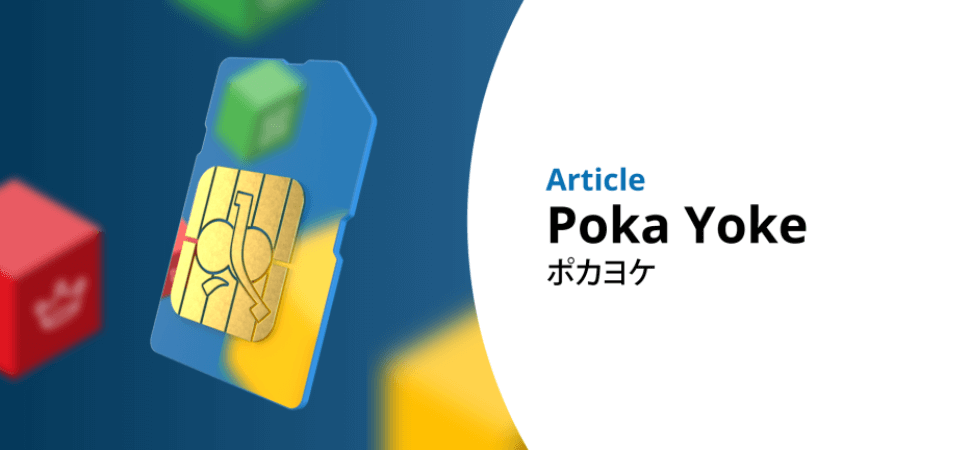The Lean Six Sigma methodology offers many tools to improve your processes with. To help you get started with these tools, we thought it helpful to highlight the most useful ones. In this article, we highlight ‘Poka Yoke’, a tool that can help you achieve better results even with a relatively minor investment.
Let’s start with the question: “What is Poka Yoke?”. Poka Yoke is a term that comes from Japanese and translates to ‘mistake-proofing’ or ‘error-proofing’. It’s a technique used in manufacturing, engineering, but also in service industries to prevent mistakes from occurring during a process.
Poka Yoke aims to make a process so simple that it becomes impossible for errors to occur. This simple elegance can be achieved through the use of devices, methods, or processes which help ensure that products/services are created or delivered without defects. By reducing errors, Poka Yoke helps improve quality, reduce costs, and of course increase efficiency.
What is the history of Poka Yoke?
Poka Yoke was developed by the Japanese engineer Shigeo Shingo somewhere in the 1960s while working at Toyota Motor Corporation. He noticed that most of the defects in the manufacturing process weren’t caused by machines malfunctioning, but by human errors. He set out to find ways to prevent these errors from occurring. Shingo developed a system of mistake-proofing devices and techniques that could detect and prevent errors before they could cause defects in the final product.
Shingo’s approach to mistake-proofing was ground-breaking because it represented a fundamentally different way of thinking about quality control and process improvement. It emphasized prevention over detection, systems thinking over individual blame, and continuous improvement over static processes.
Safe to say that these ideas have had a profound impact on the manufacturing industry and have helped many organizations improve their operations and services in a relatively easy way.
Is Poka Yoke still relevant?
For sure, Poka Yoke still offers its users a valuable tool for improving quality and productivity in both manufacturing and service environments. While there are other tools and techniques available, Poka Yoke remains a relevant and proven approach for preventing errors/defects before they occur.
One reason for this is that Poka Yoke is a relatively straightforward approach; it’s easy to understand and implement. It does not require complex technology or specialized equipment so it’s very accessible to a wide range of organizations.
Another reason why Poka Yoke remains relevant is that it is based on principles that are timeless and universal. The idea of preventing errors and defects before they occur is pretty fundamental to quality control, and the techniques used in Poka Yoke are based on a deep understanding of human behavior and the causes of errors.
Poka Yoke: What to be aware of
There are a few common pitfalls that you should be aware of when starting with Poka Yoke. For instance, while technology can help implement Poka Yoke, it’s important not to rely on it too heavily. Remember, the goal of Poka Yoke is to prevent errors from occurring, not just to detect them. It’s important to use a combination of techniques including visual aids, checklists, and sensors.
Always approach Poka Yoke from a people-centric mindset because it is most effective when employees are actively involved in the process. Be sure to involve employees while identifying potential errors and when developing or implementing solutions. This not only improves the effectiveness of the techniques but also fosters a sense of ownership and engagement. Similarly, Poka Yoke is only effective if everyone in the organization understands how it works and how to use it. It’s important to provide adequate training to employees at all levels. This includes not just training on the techniques themselves, but also on how to identify potential errors and to think from a continuous improvement mindset
Just like Lean or Lean Six Sigma are not a one-time effort, using Poka Yoke is not a one-time fix. It requires continuous monitoring and improvement to be effective over the long term. It’s important to regularly review the effectiveness of the implemented tools and to adjust them as needed, emphasizing the importance of a continuous improvement culture throughout the organization.
Finally, it’s important to ensure that Poka Yoke is aligned with the overall business goals of the organization. This means understanding how Poka Yoke can help the organization achieve its goals and ensuring that everyone in the organization is working towards those goals. Otherwise, Poka Yoke may be seen as just another initiative without a clear purpose.
So you want to get started with Poka Yoke
The threshold for starting with Poka Yoke is relatively low. Besides attending a Poka Yoke training and learning from an expert, you can follow these steps to utilize the fool-proofing method for yourself.
First, start by identifying the processes that are most prone to errors in your organization. This can be done by analyzing data, observing processes, talking to employees, etc.
Once you have identified the processes that you want to improve, conduct an error-proofing analysis. This involves identifying potential errors and their causes. You can do this quite randomly, but there are tools that can help, such as process maps, fishbone diagrams, and a failure mode and effects analysis (FMEA) if you’re looking for a more structured way of gathering potential areas of failure.
Once you have identified the potential errors, you can start implementing Poka Yoke techniques. These can include checklists, visual aids, and sensors. Choose the techniques that are most appropriate for your organization and the process you are working on. For example, a sensor should not alert you of a shelf being empty, it should alert you a shelf is nearly empty, which then triggers an order and restocking action, eliminating downtime which would normally occur.
Again, it’s important to involve employees in the process of implementing Poka Yoke. They are often the ones who have the most insight into potential errors and can provide valuable feedback on the effectiveness of the techniques being used.
Lastly, once you have implemented Poka Yoke techniques, monitor their effectiveness and adjust them as needed. Continuously improving your processes is key to achieving long-term success with Poka Yoke.
If you feel more comfortable with ‘learning’ before ‘doing’, we can recommend the online Poka Yoke training by The Productivity Company: tpc.education/en/lean-six-sigma/poka-yoke/
We’re curious if anyone has any sort of ‘I wish I knew this before I started’ tips to share, let us know in the comments.

